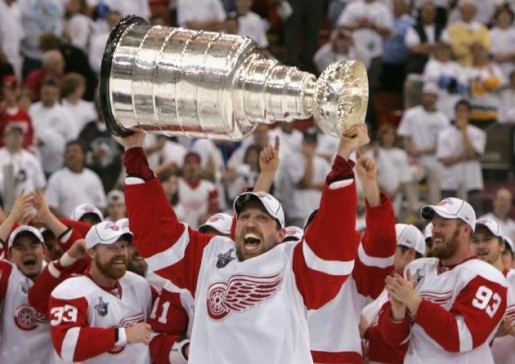Aside from the eight teams remaining in the playoffs, the rest of the NHL has shifted their focus to the offseason. For the Detroit Red Wings, the offseason brings several difficult decisions regarding their free agents. The offseason also brings about the NHL draft. Since Mike Ilitch purchased the team in 1982 and tabbed Jim Devellano as the general manager, the Red Wings have been considered the best in the draft business. Is this a valid statement? Have the Red Wings really been superior to every other team in the NHL? Does Detroit produce more prospects that make it to the NHL, or do they produce more prospects that become long-term players? Finally, does Detroit produce more superstars than other teams? These are just some of the questions I look to answer in my analysis of the NHL Draft.

Rules For This Draft Analysis
1. The first year of this analysis is the 1983 Entry Draft as that is the first year that Jim Devellano managed a NHL draft.
2. Only teams that have participated in all 31 of those drafts will be looked at. This will exclude Tampa Bay, Columbus, Ottawa, Florida, Anaheim, San Jose, Minnesota, Nashville, and Winnipeg.
3. I will look at the entire franchise over this time period. This means that the Hartford Whalers/Carolina Hurricanes, Minnesota North Stars/Dallas Stars, Quebec Nordiques/Colorado Avalanche, and Winnipeg Jets/Phoenix Coyotes will be viewed as a franchis as opposed to individual teams.
4. I am only looking at NHL entry drafts and not including players drafted in a supplemental draft.
How To Analyze Draft Success
How do you analyze whether a team was successful or not? Is it by the percentage of players they get into the NHL? Is it by the number of players that reach the 1,000 game plateau? Or is it a team having the highest points per career average for their draft picks? For me personally, if I am to evaluate how successful a team is at drafting, I think the last criterion mentioned is most important. By having the highest points per career average per draft pick, a team is showing that it has a keen eye for players that can produce in the NHL. However, games played is also an important criterion because it allows us to evaluate goaltenders. Therefore, I’ve taken a look at the total number of players drafted by each team since 1983, the percentage of draft picks that appeared in one NHL game, the percentage of picks that appeared in 100 NHL games, the percentage of picks that appeared in 500 NHL games, the percentage of picks that appeared in 1,000 games, and the average amount of goals and points a draft pick scores in his career.
Detroit’s Draft History
Since 1983, Detroit has drafted 293 players. Of those 293 players, 103 have appeared in an NHL game and nine have played in over 1,000 games. That list of 293 players also includes 24 players who have scored 100+ goals and 13 who have recorded more than 500 points. That alone is extremely impressive. Then, you remember that because of Detroit’s constant success, they have a lower draft picks than other teams. If you aren’t amazed yet, check out the table below and you’ll see why Detroit really is at the top of the class of the NHL when it comes to scouting and drafting. All data was obtained from HockeyDB.
| Detroit Red Wings | |||||||
|---|---|---|---|---|---|---|---|
| Year | Total Players Drafted | Number that played 1 game in NHL | Number that played 100 games | Number that played 500 games | Number that played 1000 games | Number of Goals | Number of Points |
| 1983 | 13 | 7 | 6 | 5 | 1 | 1323 | 3036 |
| 1984 | 12 | 3 | 2 | 2 | 0 | 200 | 527 |
| 1985 | 12 | 5 | 5 | 2 | 0 | 374 | 1050 |
| 1986 | 12 | 10 | 5 | 3 | 1 | 684 | 1517 |
| 1987 | 13 | 3 | 1 | 1 | 0 | 39 | 238 |
| 1988 | 11 | 1 | 1 | 0 | 0 | 49 | 107 |
| 1989 | 14 | 7 | 6 | 5 | 4 | 1227 | 3594 |
| 1990 | 11 | 4 | 4 | 3 | 1 | 665 | 1707 |
| 1991 | 10 | 4 | 4 | 3 | 1 | 474 | 1009 |
| 1992 | 11 | 5 | 2 | 2 | 0 | 183 | 526 |
| 1993 | 12 | 3 | 2 | 1 | 0 | 23 | 183 |
| 1994 | 10 | 3 | 2 | 2 | 1 | 312 | 429 |
| 1995 | 10 | 3 | 1 | 0 | 0 | 2 | 16 |
| 1996 | 9 | 1 | 0 | 0 | 0 | 0 | 2 |
| 1997 | 8 | 4 | 0 | 0 | 0 | 15 | 29 |
| 1998 | 11 | 3 | 2 | 1 | 0 | 283 | 864 |
| 1999 | 6 | 2 | 1 | 1 | 0 | 280 | 723 |
| 2000 | 11 | 2 | 2 | 2 | 0 | 128 | 461 |
| 2001 | 7 | 2 | 0 | 0 | 0 | 2 | 12 |
| 2002 | 10 | 5 | 5 | 3 | 0 | 372 | 972 |
| 2003 | 8 | 2 | 2 | 0 | 0 | 23 | 116 |
| 2004 | 8 | 1 | 1 | 1 | 0 | 180 | 347 |
| 2005 | 9 | 4 | 3 | 0 | 0 | 95 | 249 |
| 2006 | 7 | 3 | 2 | 0 | 0 | 65 | 129 |
| 2007 | 5 | 2 | 2 | 0 | 0 | 17 | 59 |
| 2008 | 6 | 2 | 0 | 0 | 0 | 32 | 61 |
| 2009 | 7 | 4 | 1 | 0 | 0 | 25 | 48 |
| 2010 | 7 | 4 | 0 | 0 | 0 | 11 | 33 |
| 2011 | 9 | 4 | 0 | 0 | 0 | 8 | 15 |
| 2012 | 6 | 0 | 0 | 0 | 0 | 0 | 0 |
| 2013 | 8 | 0 | 0 | 0 | 0 | 0 | 0 |
| SUM | 293 | 103 | 62 | 37 | 9 | 7091 | 18059 |
| AVERAGE | 9.451612903 | 3.322580645 | 2 | 1.193548387 | 0.290322581 | 24.20136519 | 61.63481229 |
| PERCENTAGE OF | 35.15358362 | 21.16040956 | 12.62798635 | 3.071672355 |
There is a lot of information here, but let’s break it down piece-by-piece. In terms of individual drafts, check out the 1983 and 1989 drafts. The 13 players drafted in 1983 produced 1,323 goals and 3,036 points. The 1,323 goals for a draft class is the second highest total of any draft class for any team in the last 30 years. The 1989 draft class produced 1,517 points, the second highest total of any draft class for any team in the last 30 years. Both of those figures only trail the 1984 Calgary Flames draft class which contained Gary Roberts, Brett Hull, and Gary Suter. However, when you look at the individual players in the 1983 and 1989 draft classes, you could make an argument that those two draft classes are among the best in NHL history. The 1983 class contained Steve Yzerman, Petr Klima, Joey Kocur, Stu Grimson, and Bob Probert. Not to be outdone, the 1989 draft class had an incredible four players who played in more than 1,000 games. Mike Sillinger, Nicklas Lidstrom, Sergei Fedorov, Dallas Drake, and Vladimir Konstantinov are the headliners of what is likely the greatest draft class in NHL history.

Detroit’s Draft History Compared To Rest of NHL
Looking back at the table, you can see that 35% of Detroit’s draft picks actually play a game in the NHL. This figure is a middle-of-the-pack figure when you look at the rest of the teams in the analysis. This works out to about three draft picks per class that will actually play an NHL game. This makes sense when you consider how long Detroit seasons their prospects in Grand Rapids before playing them. You can see that when a player does make the NHL, they have staying power. Of the 103 prospects that actually played a game in the NHL, 60% wound up playing in more than 100 games. That is the second best percentage in the NHL, trailing only Montreal (63.6%). Below, you’ll see how Detroit stacks up in each category with the other teams in the analysis. The teams with the best marks in each category are bolded.
| Team | % of draft picks in 1 NHL game | % of draft picks in 100 NHL games | % of draft picks in 500 NHL games | % of draft picks in 1000 NHL games | Avg # of goals/draft pick | Avg # of points/draft pick |
|---|---|---|---|---|---|---|
| Detroit | 35.20% | 21.20% | 12.60% | 3.10% | 24.2 | 61.6 |
| Boston | 43.90% | 22.70% | 9.40% | 2.50% | 18.3 | 51.3 |
| Chicago | 33.90% | 17.70% | 6.70% | 1.20% | 13 | 34.3 |
| Hartford/Carolina | 38.90% | 22.30% | 9.10% | 1.90% | 17.1 | 43.7 |
| Montreal | 41.90% | 26.60% | 12.20% | 3.80% | 12.2 | 58.8 |
| New York Rangers | 40.50% | 22.00% | 9.90% | 2.00% | 17.5 | 49.4 |
| Quebec/Colorado | 46.80% | 25.30% | 10.40% | 2.20% | 21.7 | 57.2 |
| Vancouver | 35.20% | 18.50% | 10.70% | 1.80% | 18.8 | 48.1 |
| Buffalo | 44.60% | 25.60% | 15.40% | 1.60% | 20.2 | 54.8 |
| Los Angeles | 40.90% | 18.80% | 7.00% | 2.70% | 17.2 | 46.7 |
| New Jersey | 46.50% | 26.60% | 11.30% | 4.00% | 22.2 | 59.6 |
| Philadelphia | 38.20% | 20.40% | 8.80% | 1.80% | 17.7 | 47.8 |
| St. Louis | 40.20% | 21.70% | 7.30% | 2.40% | 14 | 39.1 |
| Washington | 37.60% | 20.10% | 8.90% | 1.30% | 16.1 | 42.8 |
| Calgary | 40.60% | 20.10% | 8.80% | 2.60% | 20.1 | 50.4 |
| Edmonton | 38.00% | 19.20% | 8.00% | 1.60% | 15 | 37.9 |
| Minnesota/Dallas | 38.20% | 20.80% | 5.90% | 1.40% | 13.6 | 35.2 |
| New York Islanders | 42.10% | 22.10% | 9.30% | 1.60% | 16.5 | 45.3 |
| Pittsburgh | 41.40% | 22.90% | 9.80% | 1.30% | 22 | 58.6 |
| Toronto | 40.30% | 21.90% | 10.40% | 1.70% | 17.4 | 46 |
| Winnipeg/Phoenix | 40.30% | 20.80% | 6.70% | 2.30% | 16.6 | 43.4 |
What can we infer from this table? For starters, the top-five drafting teams over the last 30 years are Detroit, Montreal, Quebec/Colorado, New Jersey, and Pittsburgh. Funnily enough, those five teams have combined for 20 Stanley Cup Finals appearances and 14 Stanley Cups. You can clearly see why these guys are winning Stanley Cups. As for the worst teams over the last 30 years, we can clearly see that Chicago, St. Louis, and Minnesota/Dallas have had tough luck drafting. Even if you include Chicago’s recent two Stanley Cups, these three teams have combined for six Stanley Cup Finals appearances, and three championships. That may not seem unimpressive, but remember that Chicago is near the bottom in this analysis because Jonathan Toews and Patrick Kane have yet to accumulate enough points to make a significant impact on the numbers. If we were to redo this analysis in ten years, I’d fully expect Chicago’s numbers to be more middle of the pack.

After taking a look at all of these numbers it should be clear that Detroit is at the top of the class when it comes to drafting. However, the gap may not be as wide as people make it out to be. A majority of people point to the fact that Detroit has done exceptionally well with their late-round draft picks, including Pavel Datsyuk, Henrik Zetterberg, Vladimir Konstantinov, and Sergei Fedorov, but teams such as New Jersey (Steve Sullivan, Brian Gionta, Slava Fetisov) and Quebec/Colorado (Milan Hejduk, Chris Drury, Radim Vrbata) also have late-round gems. However, there is significant potential for Detroit to run away from the pack in the next few years. With Gustav Nyquist, Tomas Tatar, Anthony Mantha, and Andreas Athanasiou poised for long careers, Detroit can salt this debate away. Until that point arrives, we can safely say that Detroit is easily one of the top-three scouting/drafting teams in the NHL, but no more.
If you’d like to see the full draft analysis, please contact me via Twitter at @iyer_prashanth or email and I will send you the file.
@Jimmy So low? Datsyuk was drafted 171st overall and Zetterberg was drafted 210th overall, those aren’t low at all.
Great article. Looking at the numbers, it appears you have proved that the NHL draft is a complete crap shoot and that the best and the worst are not that different,the difference coming from the absolute total luck of getting HOF players – Lidstrom, Fedorov, Yzerman, Zetterberg, Datsyk – does this prove they are good at drafting or just lucky? I mean, even using 33 years of data, the sample size is still relatively small and one or two lucky pickups can really change everything.
Pittsburgh didn’t have to be good at drafting to pick Jagr, Lemieux, Malkin or Sid, all of which were super obvious choices and which hugley skew that data to make it seem like they are geniuses when all that happened was they got the high picks in good drafts.
Similarly you can say the Leafs have drafted badly, but if they drafted #1 a year earlier, they get Lemieux and not Wendel Clark. In 1989 they had picks #3 and #12 and picked duds in a dud draft, but if those two picks were for the drafts before or after that year, they could have had two much much better players.
The point is luck is crazy variable in drafts. When one or two HOF players can dramatically change your status over a 30 year period this becomes obvious. Detroit is no doubt good at developing playes, but they got incredibly lucky when they got Datsyk and Zetterberg so low and this makes it seem they are better than they are. Still though, amazing job, super interesting analysis/article
The only difference is Detroit’s made the playoffs every year the last 23 and have traded away the majority of their first round picks. If draft position was also included and round weighted, I bet Detroit would be absolutely clubbing everyone else.